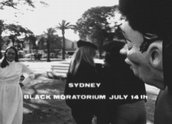


Ningla A-Na (1972)
Synopsis
Framed within an international human rights context, Ningla A-Na (Hungry for Land) begins with an excerpt from the International Labour Organisation Convention 1947 printed on the screen. This is followed by a statement from an Amnesty International report (1965) outlining Australia’s failure to conform to the Universal Declaration of Human Rights.
The film uses the television news coverage of the clash between the protesters and police at the Aboriginal Tent Embassy in 1972 to great effect, showing how the event was portrayed both nationally and internationally. Interviews with Dr Fred Hollows, Shirley Smith (Mum Shirl), Bob Maza, Carol Johnson and Paul Coe contextualise the issues advocated by the Black movement. This film gives voice to the most talented and effective Indigenous activists in the country at the time.
Curator’s notes
Ningla A-Na (Hungry for Land) holds national heritage significance as an important document of the political actions of the Black movement in south-east Australia in the 1970s, including the establishment of the Aboriginal Embassy on the lawns of Parliament House, in Canberra.
The changing of the guard from white pacifism to black activism within the Aboriginal movement takes place in front of Cavadini’s camera and he captures it beautifully. The film highlights the transition from something old, tired and worn-out to something new, energised and active. This appears in a segue from a lengthy interview with an elderly white Australian pacifist to an image of Aboriginal protestors coming into view as they march over Commonwealth Bridge towards Parliament House.
A number of historically important interviews are sown into the film. Dr Fred Hollows describes the appalling state of Aboriginal health in the 1970s and talks about the establishment of the Aboriginal Medical Centre in Redfern. Isabelle Coe points out, in a dialogue with feminists, the historic and implicit role of white women in the oppression of Aboriginal people. Paul Coe highlights the need for services for Aboriginal people and Shirley Smith talks about setting up the breakfast program for children in Redfern.
The film canvasses the opinions of white Australians watching the protest. The voice of a young boy with a broad Australian accent announces, ‘I am with the Aborigines. It’s their land … I reckon we should give it back to them.’
This cinéma-vérité documentary depicts many historically important and poignant moments. Cavadini takes his camera right into the middle of the action. You feel the adrenaline building as hundreds of police march on the Aboriginal Embassy and forcefully throw the protesters out of the way before removing the tents. Cavadini allows us to witness the chaos of the clash from a front-line perspective. In attempting to make sense of it all, you become completely engrossed in the action.
The news footage of police brutalising protesters travelled around the world. It gave international exposure to the Aboriginal rights agenda and provided a spectacle that reflected on Australia’s human rights record. The McMahon Liberal government’s decision to forcibly remove the tents dented their credibility nationally and internationally, while the subsequent Labor government, led by Gough Whitlam, gained by agreeing to give Aboriginal people land rights.
The activists in this film now hold legendary status within the Black narrative. In mounting an ongoing campaign against the oppressors, they join other heroes of the struggle like Pemulwuy, Pigeon and Jandamarra.
The Aboriginal Embassy protest changed the way the world viewed Australia: from being a colonial power with a primitive dying race of Aborigines to that of a racist country oppressing the Aboriginal people and denying them their human rights as set out in international law. All these years later this remains the pervading attitude of the world towards Australia: a lucky country, if you’re white.
Many issues raised in this film persist today. Things did change after the Tent Embassy protest but the denial of Aboriginal people’s rights still remains. As a seminal work on the Black movement of the 1970s, this film is a must-see for all Australians as it provides a mirror to a shared history.
- Overview
- Curator’s notes
- Video 3 clips
- Principal credits
- Find a copy
- Comments 2
- Map
- Add your review



